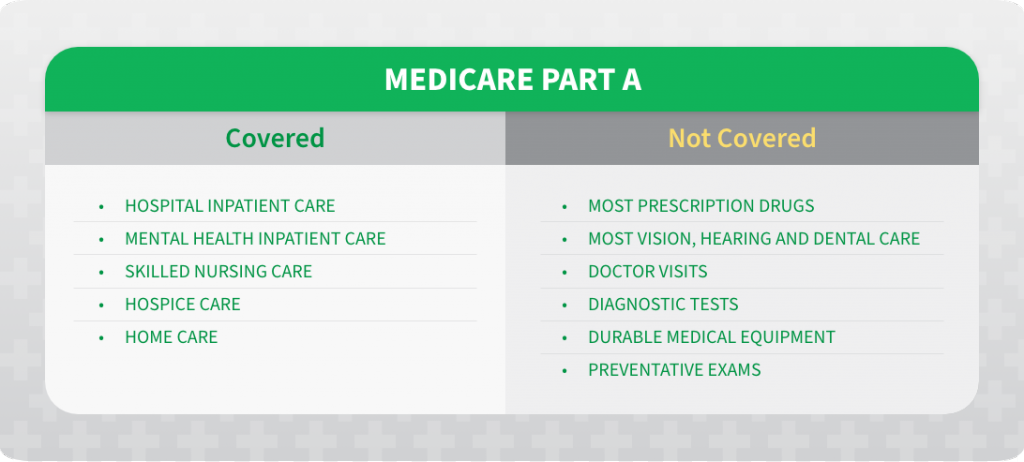Making sense of Medicare and its different parts doesn’t have to be a puzzle. To start with, Medicare is federal health insurance for adults who qualify due to age, disability or certain health conditions.
Medicare’s various parts are organized by letter. So, let’s start at the top with Part A.
What is Medicare Part A?
Medicare Part A is hospital insurance. It pays for inpatient care at a hospital or a skilled nursing facility, as well as hospice care and home care.
Medicare Part A, along with Medicare Part B, is sometimes called Original Medicare. Part B coverage pays for doctor visits, tests and some medical supplies.
Most people on Part A don’t pay a premium, but there are some out-of-pocket expenses, including a deductible and coinsurance.
What does Medicare Part A cover?
Medicare Part A covers inpatient medical care. That includes:
- Hospital inpatient care
- Mental health inpatient care
- Skilled nursing facility care
- Hospice care
- Home care
Under Medicare Part A and Part B, you can choose any doctor, health care provider, hospital or facility that is enrolled in Medicare and is taking new patients. Generally, you don’t need a referral to see a specialist.
What doesn’t Medicare Part A cover?
Medicare Part A doesn’t pay for regular doctor visits, diagnostic tests, preventative care or durable medical equipment. Those are covered by Part B.
Nor does Part A cover most prescription drugs, except those to relieve pain or control symptoms in hospice patients. Other prescription drug costs are covered by Medicare Part C (Medicare Advantage) or Part D (prescription drug) plans.
Additionally, Part A doesn’t cover most dental, hearing or vision care; long-term care; cosmetic surgery or routine foot care.
Even within the services covered by Part A, there are exceptions. For example, Part A doesn’t pay for:
- Room and board for hospice care at home or in another facility
- Private-duty nursing
- A private room, unless medically necessary
- A television or phone in your room
What does Medicare Part A cost?
The good news is most people can get Medicare at age 65 without a premium, but what if you have to pay?
Part A Premiums
If you don’t qualify for premium-free Part A, you can buy coverage for a monthly premium of $274 or $499 in 2022. The cost of the premium depends on how long you or your spouse worked and paid Medicare taxes.
If you have to pay the premium, but don’t enroll in Part A when you’re first eligible, your premium may go up 10 percent.
When you buy Part A coverage, you usually have to buy Part B, too, and will pay monthly premiums for both. But you can choose to buy Part B without buying Part A.
Deductible and coinsurance
While most people can get Part A without a premium, they still have to pay a deductible and coinsurance costs.
For example, the out-of-pocket costs per benefit period for an inpatient hospital stay under Part A are:
- $1,556 deductible
- Days 1-60: $0 coinsurance
- Days 61-90: $389 coinsurance per day
- Days 91 and beyond: $778 coinsurance per each lifetime reserve day after day 90. (You have up to 60 lifetime reserve days)
- Beyond lifetime reserve days: All costs
What’s the difference between Medicare Part A and Part B?
Part A and Part B are both grouped under Original Medicare, but they pay for different things. Part A covers inpatient care at a hospital, as well as services associated with skilled nursing care, home care and hospice care. Part B covers outpatient care such as doctor visits, preventative care, lab tests and some medical equipment.
Where can I find a primary care physician who accepts Medicare patients?
NewPrimaryCare.com can help you find a Medicare primary care doctor who puts your needs first. All of our provider partners practice value-based care, meaning Medicare rewards them for quality care and patient outcomes, rather than for the number of patients they treat.
Use our Find Your Doctor tool to search for and compare value-based care providers near you.



